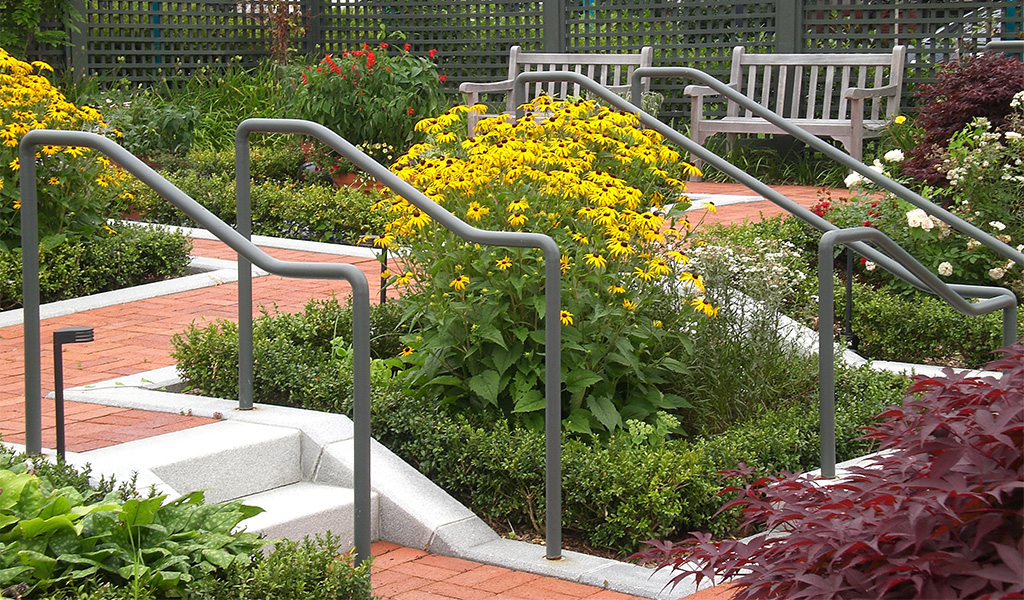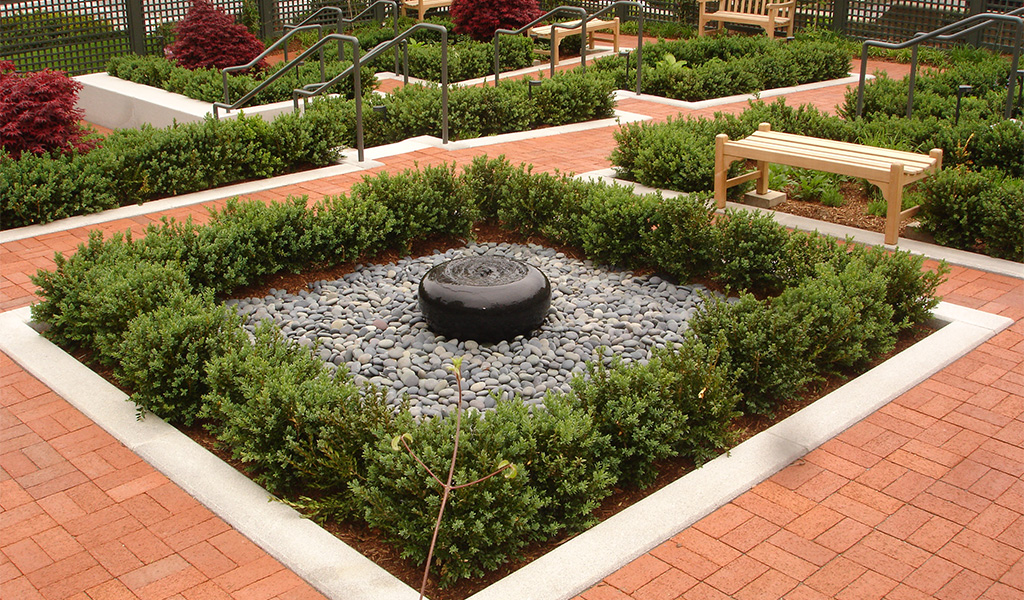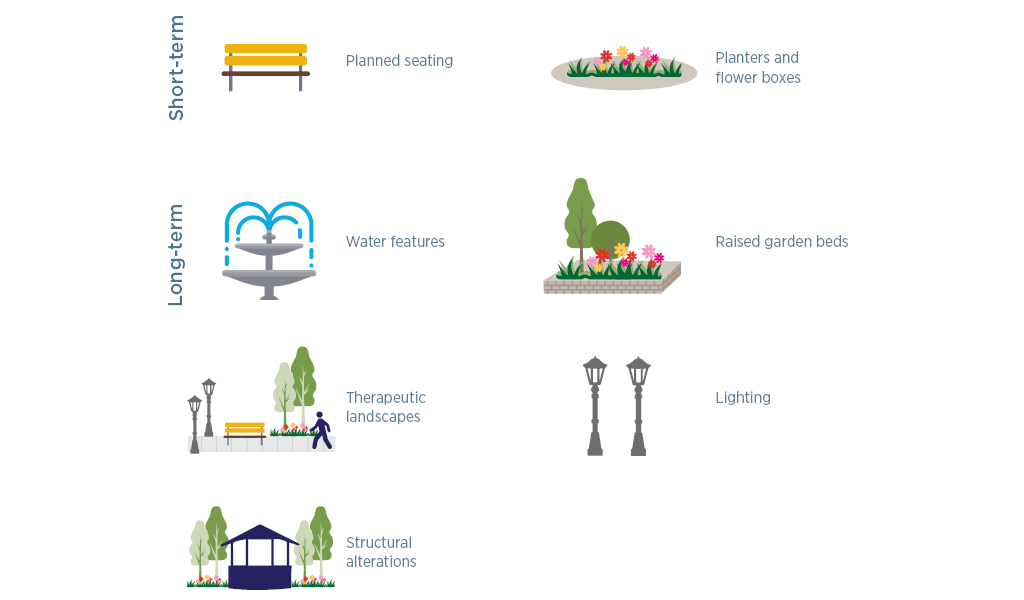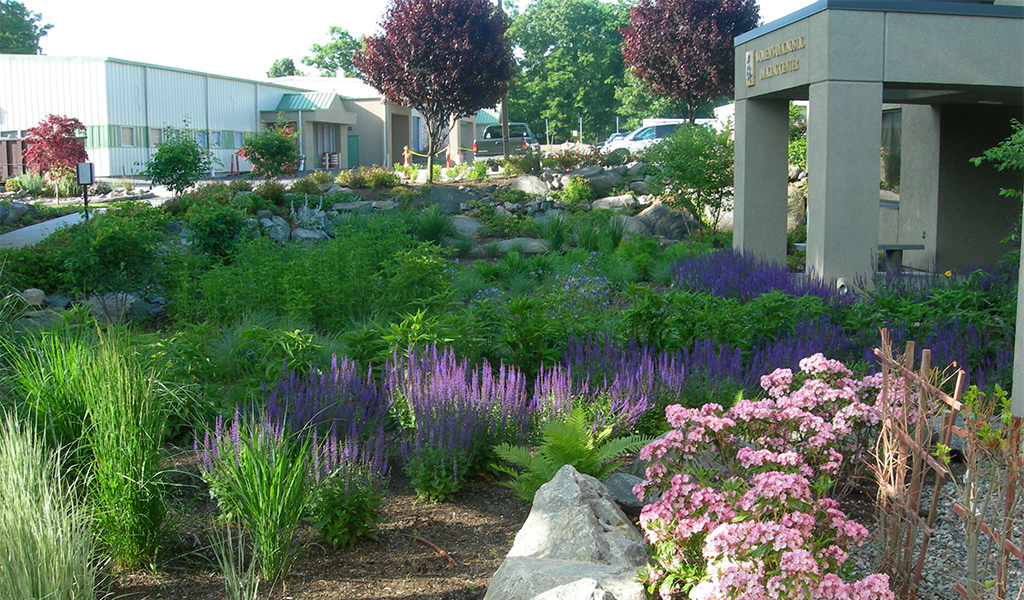With more conversation and awareness around mental health, along with the recognition that patients—young and old—need comprehensive medical resources, healthcare providers and administrators are seeking to incorporate alternative healing options into their practice, even into the design of their facilities. One trending design solution is the incorporation of healing gardens, a unique space that provides restorative care beyond traditional healthcare means to enhance patient experience. Hospitals and healthcare providers seeking to improve their patient’s health outcomes increasingly understand the importance of these natural sanctuary spaces in a patient’s recovery, both physically and mentally. In addition, the positive impact on care givers that have access to natural spaces is reflected in staff satisfaction and lower turn-over rates, which in turn can lead to better patient care.
The Link between Nature and Medicine
Nature plays a holistic role in disease prevention and health promotion. Stress and psychological factors can affect patient health outcomes, with recent studies showing that creating stress-reducing environments focused on alternative healing through sensory gardens, access to nature, green exercise, and gardening provide significant healing benefits. Associated with the theory of Biophilia, this trend has been the focus of mind-body medical science, proving that these natural spaces develop restorative qualities linked with patient-centered care.
What is Biophilia?
Humans evolved in nature and, therefore, have a predisposition to respond favorably to nature. Biophilia is a hypothetical human tendency to interact or be closely associated with living things. It also involves a spiritual connection with nature as a source for inspiration and peace. Biophilia is just one of many scientific theories backing the trend towards incorporating healing gardens into healthcare facilities.

There is strong evidence that access to nature can impact our health outcomes in positive ways. Patients can feel the effects of nature from just 10-15 minutes of exposure a day. Healing is derived through the gardens by promoting relief from symptoms, stress reduction, patient satisfaction, and improvement in their overall sense of well-being and hopefulness. Additional benefits attributed to healing gardens include:
- Reduced depression
- Decreased agitation and aggressive behavior
- Improved mental clarity
- Improved hormone balance and vitamin production
- Enhanced immune functioning
- Better sleep patterns
These resulting benefits require less dependence on medications and lower the demand on staff, which decreases staff stress and increases employee satisfaction and retention.
Design Standards in Applied Settings
As A/E/C professionals, it is important to acknowledge that codified standards need to be developed as healing gardens grow in popularity. While these spaces provide additional healing therapies for patients, it is not a one-size-fits-all solution. One design will not work for every patient—or every facility. We must collaborate with healthcare professionals to determine the standards needed for design implementation in all facility categories.
There are various types of natural spaces to consider in a facility’s design. Healing gardens, designed to provide benefits to a diverse population with varying needs, have a more passive involvement, such as relaxing on a park bench, seating arrangements that promote quiet conversation, or simply enjoying the surrounding environment. Therapeutic landscapes and gardens meet a particular need of a specific patient population, whether it is the elderly living in long-term care centers or cancer patients receiving treatment. They engage patients actively and deliberately through a variety of therapeutic activities, such as gardening or green exercise.
Healing garden design considerations include functionality, maintainability, aesthetics, simplicity, variety, balance, sequence, and scale. These natural spaces must accommodate the specified end user, while at the same time be visually pleasing by providing seasonal interest, sensory stimulation, textures, and colors, as well as be simple in form and easy for the visitor to understand and maneuver. The gardens must also be accessible for maintenance, address security protocol, and be designed in relation to the size of space and adjacent buildings, considering the built scale, transition between spaces, sense of stability, and equal distribution.
Inclusive Programming for All
Determining the appropriate programming that is in line with a set budget is an important step towards any successful healing garden. The level of programming impacts both required staffing and maintenance. Programming can be as simple as a passive shaded outdoor seating area that does not require hands-on staff assistance or as intricate as a setting for a trained horticultural therapist leading a group patient activity or one-on-one physical therapy session. Alternatively, a lack of programming may not have the appeal or effectiveness for the right population. In addition, there will be specific design implications for each population. For example, patients going through chemotherapy are sensitive to highly fragrant flowers, while those completing physical therapy may need easier transitions to walkways or gardens free of obstacles.
Programming should account for regional differences and seasonal changes affecting the overall design of healing gardens as well. Aspects that are incorporated in New England will differ from those in the Southwest. For example, having visible color integrated throughout the garden year-round yields higher patient outcomes, versus a wilted or dead garden experienced during the winter months. Water features should look nice when not in use, and lighting extends the duration of usable hours well into the evening.
Additionally, the age and physical capability of a patient is a factor in the design of these spaces. While all generations benefit from natural spaces, different age groups seek distinctive features and conditions which may dictate the need for varying levels of supervision. Elderly and patients that have restrictive conditions on activity enjoy peace and quiet with dedicated places to sit and enjoy the landscape, listening to the sound of moving water, watching the birds, or enjoying the wind movement of kinetic sculptures. The middle aged or more active adults may seek stimulation through hands-on activities, such as filling bird feeders and participating in gardening activities. Young children like interactive features, such as sculptures to climb on or miniature games, mazes, or brain teasers placed throughout a space.

Strategically Implemented Gardens
Although healing gardens are desirable, many healthcare providers struggle to find the balance between quality patient care and the costs associated with implementing these unique spaces into their facilities. Value engineering is key when guiding the client on what features can be incorporated into their healing garden. Planners and designers can help determine the best solutions for available budgets and identify what can be incorporated immediately versus later. Strategically right-sizing spaces and planning for both short- and long-term needs through phased implementation can help program features to meet the budget and resource capabilities of the facility without hindering patient health outcomes—yielding benefits for patients and providers alike.
While funding to incorporate a fully designed healing garden may be limited, there are some simple ways that healthcare facilities can achieve a connection to nature that patients will still find beneficial. Initial features that could be implemented as short-term solutions include planned seating, both inside in front of large windows and outside along shaded sidewalks or pathways, as well as planters and flower boxes placed purposefully throughout a facility. Long-term, secondary priorities could include water features, raised garden beds, therapeutic landscapes, lighting, and physical alterations to the structural aspects of garden space.
Right-sizing Spaces to Meet Budget and Resource Capabilities.

VHB’s professionals are passionate about making meaningful contributions to the world through the work that we do. We deliver value by embracing our clients’ goals through considered design applications for the appropriate facility and always providing a seamless path towards comprehensive healing. Client partners we have teamed with to help design healing gardens within their facilities include:
- Outdoor space planning and design for Sentara Rehabilitation and Care Residence in Chesapeake, Virginia, including ADA accessible walkways linking multiple courtyards, sun and shade options with flexible seating, water and recreational features, and specific plants to assist in the rehabilitation of their patients.
- A healing garden programmed with the patient in-mind for the Northwell Health’s Imbert Cancer Center on the South Shore of Long Island in Bay Shore, New York. The design featured raised planter beds, stone seat walls, water feature, a therapeutic sound-generating instrument, glass mulch, paver walkways, 20-foot diameter pre-cast concrete nautical compass inlay, shade structures, bench seating, art sculptures, and bermed multi-season landscape plantings.
- Healing garden design for St. Luke’s Hospital in New Bedford, Massachusetts, featuring a fountain, benches, and extensive planting of flowering trees, shrubs, and perennials.
- Integration of sustainable landscape design, as well as wellness and healing principles into low impact design (LID) landscape improvements for Kent Hospital’s new Emergency Department, Women’s Diagnostic Imaging Center, and Care New England’s on-site Data Center Facility in Warwick, Rhode Island, including a rain garden, bioswales, and pavement design.
- Partnering with NuHealth to develop a conceptual site/landscape plan focused on aesthetic landscape involving healing gardens for the Nassau University Medical Center in East Meadow, New York.
- Planning, design, engineering, and landscape architecture for Tysons Corner Medical Center in Tysons Corner, Virginia, including a garden pavilion addition and South Terrace healing garden.
As leaders in this field, VHB is committed to working together to balance budgets with quality of care, prioritize programming, and identify innovative and efficient solutions for natural sanctuary spaces. We welcome the challenge of assisting our hospital and healthcare partners in smart decision-making to incorporate balanced healing alternatives.

How VHB Can help
VHB’s understanding of landscape design and planning, as well as the importance of how our designs impact the health outcomes of patients, makes us uniquely qualified to provide clients with the guidance they need to navigate this new frontier in healthcare design. Contact Nancy Rodrique or Carlos Vargas to learn more about our innovative and forward-thinking integrated service solution approach and how we can help you incorporate a healing garden into your healthcare facility. Our goal hasn’t changed. We want to assist hospitals and healthcare facilities in thinking strategically about providing the best possible care options to their patients and how they can achieve these results; however, the skills and knowledge needed to deliver on these goals are changing—and VHB is leading the way.




